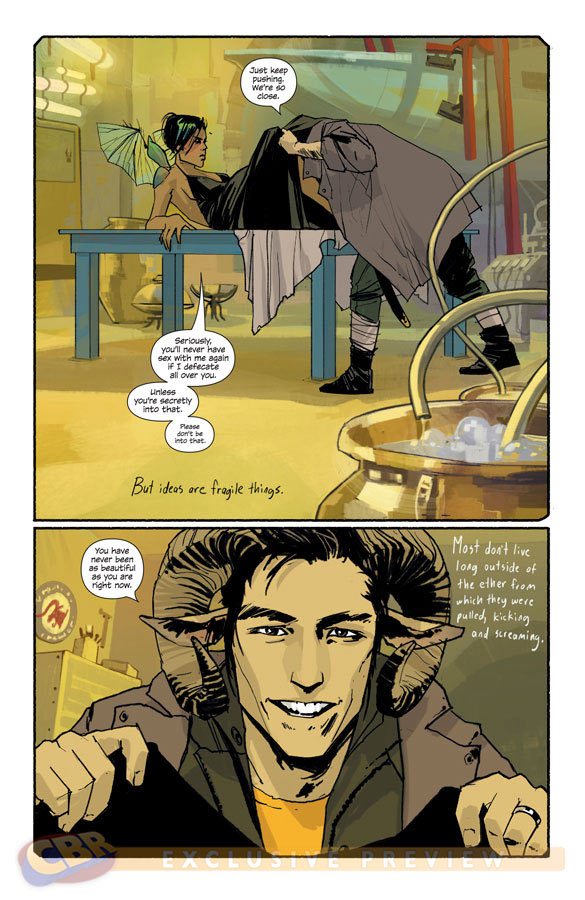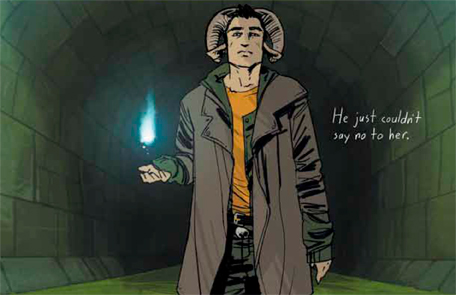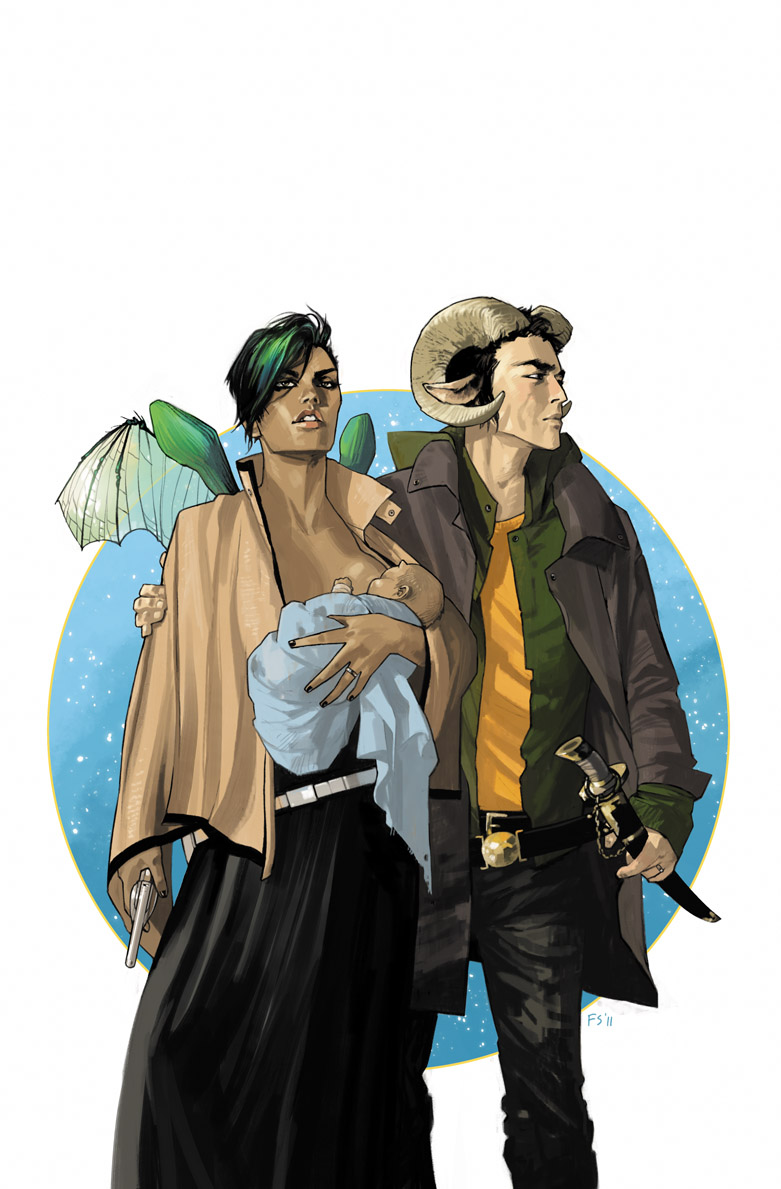Review: Saga #1
Much has been said about 2012 being the year of creator-owned comics, and the reasons why. Here isn’t the place to go into detail into the various factors that could have influenced their increased prominence, but I will venture to say that Image is at the centre of it, and that in their 20th year, they have the biggest talent lineup of any comics publisher. Marvel has done much to publicise its A-list writers as Architects recently: Brian Michael Bendis, Ed Brubaker, Matt Fraction, Jason Aaron and Jonathan Hickman. DC, meanwhile, has such top-flight talent as Grant Morrison, Geoff Johns, Scott Snyder, Jeff Lemire and Paul Cornell at its disposal. But, writing either current or upcoming books, Image has a talent roster that includes Robert Kirkman, Grant Morrison, Mark Millar, Ed Brubaker, Jonathan Hickman, Nick Spencer and, the subject of much of this review’s discussion, Brian K Vaughan. That’s some of the top dogs from both Marvel and DC, as well as heavy hitters currently doing work for neither. Image, it seems, is the place to be right now, and that has been reflected in their recent output. It’s beginning to feel like barely a week goes by without an exciting new Image debut. Fatale. Thief of Thieves. The Manhattan Projects. But arguably the most anticipated debut of them all, and in my entirely subjective opinion the true biggest comic event of the year, is Saga.
 Of course, Saga isn’t going to match the brand awareness of Batman or Spider-Man, but for a creator-owned comic, it has received quite a lot of press and attention, both within comics news circles and even in some mainstream outlets. A big part of what has drawn so much attention to the book is that it’s the return of Brian K. Vaughan – who made his name on acclaimed comics like Y: The Last Man, Ex Machina and Pride of Baghdad, but who more recently found success on a grander stage by writing some of the later seasons of Lost – to the world of comics, after an absence of several years. That, to me, is exciting in itself. That a creator rather than a character can make a comic an event. It’s a ropey analogy until we see how successful Saga #1 (already a sell-out at distributor level) is, and I should mention that I didn’t really like this movie, but it reminds me a bit of Avatar a couple of years back. Here was a movie that wasn’t a sequel, or a remake, or an adaptation of an established franchise, but it was a hit, and people flocked to cinemas to see it, because on one level it featured the return of a creator celebrated as a master of his craft, and on a simpler level it felt like something original, exciting and new. We need something like that in the comics world, and Saga might just be it. Of course, in talking about all that this comic might represent, we’re not even getting into the discussion of whether or not Saga #1 is any good. Well, it is. Very, very good.
Of course, Saga isn’t going to match the brand awareness of Batman or Spider-Man, but for a creator-owned comic, it has received quite a lot of press and attention, both within comics news circles and even in some mainstream outlets. A big part of what has drawn so much attention to the book is that it’s the return of Brian K. Vaughan – who made his name on acclaimed comics like Y: The Last Man, Ex Machina and Pride of Baghdad, but who more recently found success on a grander stage by writing some of the later seasons of Lost – to the world of comics, after an absence of several years. That, to me, is exciting in itself. That a creator rather than a character can make a comic an event. It’s a ropey analogy until we see how successful Saga #1 (already a sell-out at distributor level) is, and I should mention that I didn’t really like this movie, but it reminds me a bit of Avatar a couple of years back. Here was a movie that wasn’t a sequel, or a remake, or an adaptation of an established franchise, but it was a hit, and people flocked to cinemas to see it, because on one level it featured the return of a creator celebrated as a master of his craft, and on a simpler level it felt like something original, exciting and new. We need something like that in the comics world, and Saga might just be it. Of course, in talking about all that this comic might represent, we’re not even getting into the discussion of whether or not Saga #1 is any good. Well, it is. Very, very good.
Allow me to illustrate. I bought 14 comics this week. Crazy, I know. That’s a lot of reading to get through, but thus far I’ve only read one of those comics: Saga. And I read it twice. Given that this first issue is 44 pages (more on that later), that’s time I could have given over to reading another 2 comics from my pull list. But instead I felt more compelled to reread Saga #1 – and it was even better on repeat reading! The world created within and all the narrative possibilities that it could contain were buzzing around in my head all day, so much so that I probably couldn’t concentrate if I tried to read another comic. This one deserved to simmer a little longer. Of course, Vaughan has a reputation for delivering killer first issues. But Saga #1 can’t boast the deliciously simple high concept established in Y: The Last Man #1 or the jaw-dropper of a last page reveal found in Ex Machina #1. Instead, Saga #1 builds a world, or rather, worlds. At its core is an intimate love story, but that love story is placed within a mythology that already feels truly epic in scope, a world that could spawn any number of compelling narratives. I initially thought Saga was a pretty vague title for a book, but once you read the first issue you will see that it absolutely fits.
In attempt to explain in concise fashion (Ha! Concise, he says after 750+ words ) the world of Saga, it seems like we are getting to see the kind of mythical world we might find in fantasy, only instead of being in the distant past, this story is set in a sci-fi future where the fawns and fairies have colonised space, and interact with robots, aliens and anthropamorphised animals. The inhabitants of the planet Landfall are at war with the natives of Wreath, its orbiting moon, and have been for as long as anyone can remember. To keep their respective homeworlds safe, the two warring factions have turned the other planets in the galaxy into their battlefield. It may be a bit premature and simplistic to say there are parallels to the conflict between Israel and Palestine, but we’ll see how that angle develops. Against this backdrop, Alana from Landfall and Marko from Wreath have fallen in love, married and, as the story begins, had a child together. And now they find themselves hunted by both sides.
With the sci-fi/fantasy hybrid, people might be tempted to throw around a Star Wars meets The Lord of the Rings soundbite. In fact, this plays out more like Battlestar Galactica meets Game of Thrones , in terms of the adult content and political intrigue. The 44 pages we’re given for this first issue are truly a blessing (all the more so when you consider it’s 44 pages for $2.99!!), as it really helps to get us immersed in this dense mythology, and to feel like we’ve gotten a full, meaty, satisfying reading experience from this opening chapter. We not only get to know Marko and Alana – and Vaughan very quickly makes us care about these characters, and worry that their story will have a tragic end – but we also get to experience time behind enemy lines on both sides of the intergalactic conflict, seeing both the shady authority figures and sympathetic characters who believe in their respective causes. Prince Robot IV is introduced in eye-popping fashion, and his is an example of a side character who has an implied rich narrative of his own, in terms of the history and the heirarchy of robots in this society, that we’ll hopefully learn more about later. On the other side, jaded human (?) bounty hunter The Will emerges as perhaps the most badass character of the first issue, and a potential scene-stealer.
What you might get from my observations about the ensemble is that we’re very much dropped in on the moment, with characters having a past and motivations that may be referred to, but we haven’t yet seen. Rather than exhausting us with info dumps, Vaughan has very cleverly populated his book with a cast of immediately interesting characters who we will be keen to discover more about in the future, but for now we are utterly compelled in the actions they’re presently engaged in.
Another clever technique Vaughan employs is the use of a voiceover as a narrative framing device, in the form of Hazel – Alana and Marko’s baby – speaking as an old woman at some point in the future. This injects the story with a degree of dramatic irony, as she alludes to future disasters that the characters themselves are unaware of. The idea of having an inkling of the ending right from the beginning is something that Vaughan toyed with to great effect in Ex Machina, but the execution here is quite different. And throughout the issue, we see Vaughan flexing different creative muscles. Vaughan has often been widely recognised for his knack for naturalistic dialogue, and the density of pop culture references and obscure trivia has become something of a motif for him. But by deliberately placing himself in a position where those traits have to be stripped away, we see Vaughan focusing more on the impecabble mastery of narrative structure that has always been there too. Vaughan is a writer with a high density of undeniable comics classics in a relatively short career, but alreadySagashows signs of added gravitas, a suggestion that this could grow to become his most mature work to date.
 But through all this, we haven’t even gotten round to showering praise on the incredible work of Fiona Staples! On the basis of one issue, I think Miss Staples has already cemented her position as breakout artist of the year. If there is any justice in the world, Saga is going to make her a superstar artist. As penciller, inker, colorist and even letterer for the voiceover portion of the book (with primary letterer Steven Finch doing a great job in his own right of giving each species its own distinct font), Fiona Staples is this book’s definite visual architect, and under her pen, this book just soars. Whether it’s an intimate love scene or an epic battle, or the coldness of space, the rough lines, earthy color palette and occasional storybook-style painterly brushstroke make everything feel like part of a cohesive whole, something visually distinct.
But through all this, we haven’t even gotten round to showering praise on the incredible work of Fiona Staples! On the basis of one issue, I think Miss Staples has already cemented her position as breakout artist of the year. If there is any justice in the world, Saga is going to make her a superstar artist. As penciller, inker, colorist and even letterer for the voiceover portion of the book (with primary letterer Steven Finch doing a great job in his own right of giving each species its own distinct font), Fiona Staples is this book’s definite visual architect, and under her pen, this book just soars. Whether it’s an intimate love scene or an epic battle, or the coldness of space, the rough lines, earthy color palette and occasional storybook-style painterly brushstroke make everything feel like part of a cohesive whole, something visually distinct.
Miss Staples also scores top points on character design. One quite compelling argument I’ve read in defense of superhero comics having the dominance of the medium that they do is that comics depend on being visually engaging, and the colorful, skintight outfits and action-packed adventures of superheroes offer that spectacle for the eyes in a way that tales of other genres can often find it hard to compete with. But Saga is populated with characters infused with sci-fi and fantasy influences that are as visually dynamic as anything you’d find in a capes-and-tights book. This may be an odd compliment, but I could imagine action figures being made of most of the principal players introduced here, and I’d want them all on my shelf!
This little point about toyetic characters would be a natural point to talk about how Saga feels like a story with heaps of cross-platform franchise potential. Already I could imagine a movie, or a TV series, or a video game. But at the same time, and this is important, while all those possibilities might be tantalising, this in no way feels like it’s being farmed out for adaptation. This is absolutely a comic, embracing and celebrating the inherent strengths of this medium, and it’s the kind of tale that I don’t think any other medium could pull off quite as well. And crucially, Fiona Staples has already left such a strong imprint that I fear for the success of any attempt at adaptation (or, indeed, any future fill-in artists), as a Saga not drawn by Fiona Staples would just not feel like Saga.
As you all know, Scalped is my comic book crack, the serialised bliss that I need my monthly fix of. But Scalped is coming to an end, and I fear its conclusion will leave a large void in my comic collection, nay, my LIFE! It’s early days yet, and there’s always the possibility of subsequent chapters failing to match this astonishing opener, but if the quality keeps up and even improves (as Vaughan’s stories tend to do), that void could very well be filled.
Saga #1 gives us a gripping narrative, and it looks absolutely stunning. What more do you want from a comic? Brian K Vaughan and Fiona Staples have delivered a triumph. When the sales for this month come in, it probably won’t topple the old favourites like Justice League or Batman or even this week’s Avengers Assemble, but it should. Saga #1 deserves to be the biggest book of the month, it deserves the biggest audience it can get. It may be a bit late to say this now, as here in Glasgow at least it’s already entirely sold out, but if you’re a comic fan, even if you’re a casual I just read trades fan, you owe it to yourself to pick up this book. Believe the hype.
***
Artist: Fiona Staples
Letterer: Steve Finch of Fonografiks
Publisher: Image
Price: $2.99
Synopsis: Y: THE LAST MAN writer BRIAN K. VAUGHAN returns to comics with red-hot artist FIONA STAPLES for an all-new ONGOING SERIES! Star Wars-style action collides with Game of Thrones-esque drama in this original sci-fi/fantasy epic for mature readers, as new parents Marko and Alana risk everything to raise their child amidst a never-ending galactic war. The adventure begins in a spectacular DOUBLE-SIZED FIRST ISSUE, with forty-four pages of story with no ads for the regular price of just $2.99!
Saga #1 is available in all good comic stores that haven’t sold out yet!
Related Posts:
Category: Comics, The Creator-Owned Zone


















Great review, John. I agree with most of your points.
I think you nailed it on the head, with your more like “Battlestar Gallactica” meets “Game of Thrones” than “Star Wars” meets “Lord of the Rings.” My only lament about the book is that I feel like comics could really use the latter…but because SAGA is the former, it won’t be the comic market expanding savior book people were hoping for.
Love the big ideas and the not so subtle themes BKV weaves into his work. I love that so much of his stuff focuses on nature of creation and creativity and ideas themselves.
Not so sure about the TV head naked robots…but hey, everyone’s got their thing.
Will probably read this in trade, but glad I read the first issue.